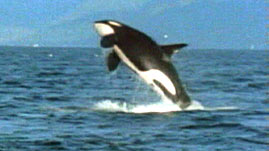Teachers' Domain - Digital Media for the Classroom and Professional Development
User: Preview


Source: Evolution: "Evolving Ideas: How Do We Know Evolution Happens?"
NARRATOR: How do we know evolution happens?
JOHN BANISTER-MARX, Teacher: Fossils provide the most interesting evidence for evolution, and certainly the most powerful for most people.
PHIL GINGERICH, Paleontologist: I want you to look behind us…
NARRATOR: There is an abundance of hard evidence at the molecular, chemical and anatomical level that evolution happens. But perhaps it's the clues hardened in stone that tell evolution's story most vividly.
GINGERICH: There are the backbones. You can see how big these vertebrae are. The history of life is all a record in fossils. Millions of them from strata layer by layer by layer back through time are all interconnected. Now, partly, this layering and succession is how we tell time in geology. But it's also the principal evidence that life has changed through time; that life has evolved through time; that the things living today can all be connected back through time to common ancestors.
NARRATOR: These now lifeless dry rocks are gold to paleontologists. They are the puzzle pieces to the origin of one of the most powerful and majestic animals on Earth—the whale.
NEIL SHUBIN, Paleontologist: The evolution of whales has always been sort of a mystery. They're like us in that they're very intelligent. They're mammals; they're warm-blooded. They nurse young and feed them milk. But they're very, very different. I mean, they live in water. They can hear in water and they swim around like fish.
So the question is this: We know that mammals originally evolved on land, yet whales live in the water. How did that shift, how did that evolution happen from life on land to life in the water?
NARRATOR: That question consumes paleontologist Phil Gingerich. The evolution of whales has been his passion ever since 1978, when his team unearthed a rock in Pakistan that appeared to have a skull embedded in it.
GINGERICH: When we found it, all you could see was the braincase. I thought it was a... a wolf-like animal with a very small brain. When it was cleaned, the ears were uncovered, and I could see that it had a very characteristic whale ear. And that shows us that what we have is a whale—not a wolf, not a deer, not some other kind of mammal, but a fossil whale.
NARRATOR: Gingerich named the whale ancestor Pakicetus. With only its skull as evidence, scientists do not know for sure what the rest of Pakicetus looked like, but some scientists hypothesize that it resembled a modern seal.
GINGERICH: Okay, look at this, Bill.
NARRATOR: Paleontologists look for fossils that have transitional features from one way of life to another. They use these related forms to create a comprehensive picture of evolutionary change.
When fossils of related species are located, scientists organize them by their physical similarities. Sometimes these similarities don't evolve all at once, like the whale ear of Pakicetus, which lacks many other whale-like features in its backbone and limbs.
SHUBIN: Whales' bodies contain inside them, connections, or clues, to their past. I mean, their mammalian traits are signs of their recent history, but there are also signs of a very ancient history. Take their flippers. On the outside, their flippers look like fish fins, but on the inside, the bones of that flipper are very similar to those in a monkey's arm, in the wing of a bird and in the limb of a frog.
NARRATOR: Egypt today seems an unlikely place for Phil Gingerich to find intermediate whale fossils.
GINGERICH: This is Whales' Valley in Egypt. You can see behind me there are many hills of sandstone standing above shale. What's important, it's called Valley of Whales because there are about 400 skeletons of whales weathering out here.
This was a wide-open, blue sea with the full range of sea life living in it—a lot of invertebrate shellfish, sharks, about five or six kinds of whales living here.
NARRATOR: Gingerich searches for intermediates with hind limbs and feet, to trace back until those feet and hind limbs are as big and fully functional as any four-footed animal that lives on land.
GINGERICH: It is a Basilosaurus—look at this. Here's the skull, incisors up front. The rest of the teeth come back to here. And then the whole length of the skull is over a meter.
NARRATOR: His find, Basilosaurus, had tiny hind legs with a mobile knee and several toes and lived 35 to 41 million years ago.
Here's where scientists place this transitional form on the fossil record. The discovery of another fossil has led scientists to conclude that whales evolved from a land mammal much like this one, called Sinonyx.
Perhaps its descendants found the water a source of abundant food and a haven from competition. Over millions of years, through variation and selection, front legs became fins, rear legs disappeared, bodies lost fur and took on their familiar streamlined shape.
SHUBIN: Whales show us the sheer creative power of evolution. I mean, from a wolflike creature to a whale in ten or so million years is... is amazing.
NARRATOR: Each dig and discovery adds more stone, more bone, more hard evidence for evolution, for the origin of life, for its history here on Earth and for the evolutionary relationships among all forms of life.
 Loading Standards
Loading Standards Teachers' Domain is proud to be a Pathways portal to the National Science Digital Library.
Teachers' Domain is proud to be a Pathways portal to the National Science Digital Library.
